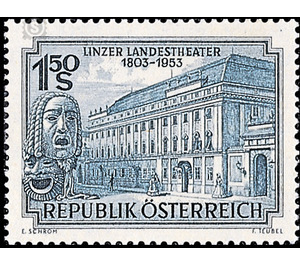150 years - Austria / II. Republic of Austria 1953 - 1.50 Shilling
Theme: Art & Culture
| Country | Austria / II. Republic of Austria |
| Issue Date | 1953 |
| Face Value | 1.50 |
| Color | green |
| Printing Type | Typography |
| Stamp Type | Commemorative |
| Item Type | Stamp |
| Chronological Issue Number | 331 |
| Chronological Chapter | OOS-OE2 |
| SID | 766602 |
| In 40 Wishlists | |
On 4 October 1953, the Linz Landestheater can look back on a 150th anniversary. But his theater history is much older. The first evidence of theatrical performances we received dates back to June 20, 1492. On this day, the old Emperor Frederick III. in the presence of Venetian ambassador to his venerable castle at Linz Delius, who had recited verses to him, to the poet and it is safe to assume that for the first time in Linz, the lyrical-orchestral festivals in the character of the Italian Renaissance made their entry. In the spring of 1501 Emperor Maximilian I stayed with his wife Bianca Sforza, surrounded by the princes of Milan and the whole court in Linz. On the 1st of March, the splendid performance of the "Ludus Dianae" by Conrad Celtis took place in the large ballroom of the castle. For the first time in the history of the theater in general we encounter the idea of including the imperial person as the highest of the scene in the play, which was to become common practice later in the Baroque age. Around 1521, the Reformation then found its mirror image on stage in the so-called school drama. From 1578 to 1595 Georg Calaminus was a teacher of classical languages at the Linz Landscape School. Of his many Latin dramas, his tragedy "Rudolphus et Ottocarus" is of interest in the field of theater science, because many passages in the poem Calaminus are strongly influenced by Franz Grillparzer's "King Ottokar's Luck and End", for example the verses on the award of Austria: The Grillparzer in the third act of his drama Horneck puts in the mouth. The brand image shows the Linzer Landestheater after an old representation.


